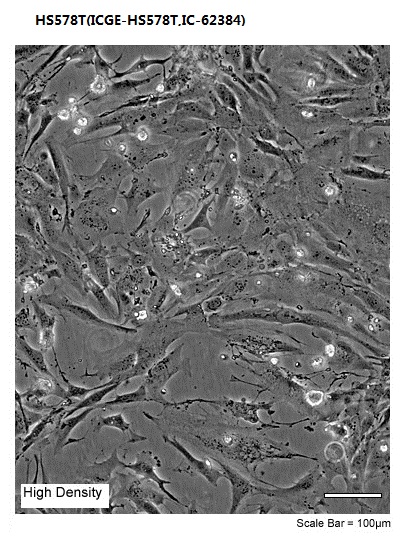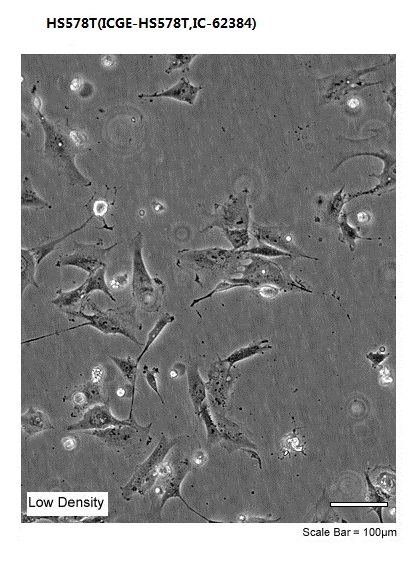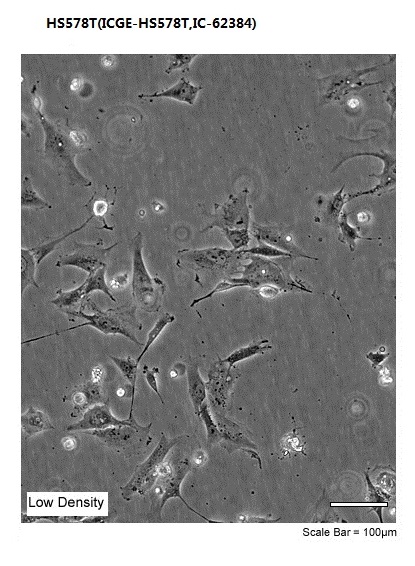


Overview
| Organism | Homo sapiens, human |
|---|---|
| Tissue | mammary gland/breast |
| Cell Type | epithelial |
| Product Format | frozen |
| Morphology | epithelial |
| Culture Properties | adherent |
| Biosafety Level |
1
Biosafety classification is based on U.S. Public Health Service Guidelines, it is the responsibility of the customer to ensure that their facilities comply with biosafety regulations for their own country. |
| Disease | Carcinoma |
| Age | 74 years adult |
| Gender | female |
| Ethnicity | Caucasian |
| Storage Conditions | liquid nitrogen vapor phase |
Properties
| Karyotype |
This is a hypotriploid human cell line with a modal chromosome number of 59. QM staining verified the absence of a Y chromosome. The rate of polyploidy in excess of the modal number is 33.8%. There were 8 consistent derivative chromosomes: del(1)(q12), del(2)(?q36), der(3)t(3;15)(q10;p10), der(5)t(5;8)(p10;q10), i(6)(p10), del(11)(p12),i(17)(q10), der(19)(19pter<-q13::5q13<-qter) plus two markers of unknown origin and one minute chromosome. Normal chromosome 17''''''''s were absent and only a single normal 15 was seen in most cells. No brightly fluorescent Y chromosomes were detected with QM staining. Number of cells examined = 50; Modal Chromosome Number = 59 with a range of 50 to 77; Polyploidy Rate = 33.8% Composite karyotype: 50-77 <3n> X, -1, del(1)(q12), -2, del(2)(?q36), der(3)t(3;15)(q10;p10),-4, -5,der(5)t(5;8)(p10;q10),-6, i(6)(p10), +8, -9, -10, -11, del(11)(p12), -12, -13, -14, -15, -15, -16, -17, -17, -17, i(17)(q10), -18, -19,der(19)(19pter<-q13::5q13<-qter), +22, +3 mar[cp12]. There are 8 consistent derivative chromosomes: del(1)(q12), del(2)(?q36), der(3)t(3;15)(q10;p10), der(5)t(5;8)(p10;q10), i(6)(p10), del(11)(p12), i(17)(q10), der(19)(19pter<-q13::5q13<-qter) plus two markers of unknown origin and one minute chromosome. Four other markers, including two derivative chromosome 1s were noted are lower frequency. |
|---|---|
| Images |

|
| Derivation |
It was originated by A.J. Hackett, et al. along with the Hs 578Bst (see ATCC HTB-125), which is a normal fibroblast-like line from the same patient.
The Hs 578T cell strain was derived from a carcinoma of the breast.
|
| Clinical Data |
74 years adult
along with the Hs 578Bst (see ATCC HTB-125), which is a normal fibroblast-like line from the same patient.
Caucasian
female
|
| Receptor Expression |
Receptor expression: estrogen receptor, not expressed Ref
|
| Tumorigenic | No |
| Effects |
No, in immunosuppressed mice
Yes, in semisolid medium
|
| Comments |
Aggregates of casein protein granules, desmosomes, tight junctions, lipid droplets and vesicularized smooth endoplasmic reticulum were observed by electron microscopy. As with Hs 578Bst, no estrogen receptors or endogenous viruses were detected.
|
Background
| Complete Growth Medium |
The base medium for this cell line is ATCC-formulated Dulbecco''''''''s Modified Eagle''''''''s Medium, Catalog No. 30-2002. To make the complete growth medium, add the following components to the base medium: 0.01 mg/ml bovine insulin; fetal bovine serum to a final concentration of 10%. |
|---|---|
| Subculturing |
Volumes are given for a 75 cm2 flask. Increase or decrease the amount of dissociation medium needed proportionally for culture vessels of other sizes.
Subcultivation Ratio: A subcultivation ratio of 1:3 to 1:8 is recommended
Medium Renewal: 2 to 3 times per week
|
| Cryopreservation |
Freeze medium: Complete growth medium supplemented with 5% (v/v) DMSO
Storage temperature: liquid nitrogen vapor phase
|
| Culture Conditions |
Atmosphere: air, 95%; carbon dioxide (CO2), 5%
Temperature: 37��C
|


